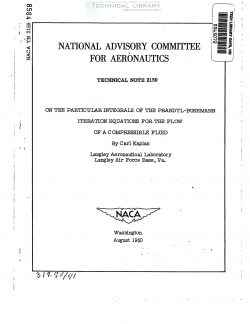naca-tn-2159
- Version
- 148 Downloads
- 581.75 KB File Size
- 1 File Count
- December 12, 2016 Create Date
- December 12, 2016 Last Updated
National Advisory Committee for Aeronautics, Technical Notes - On the Particular Integrals of the Prandtl Busemann Iteration Equations for the Flow of a Compressible Fluid

The particular integrals of the second-order-and third-order Prandtl—
Busemsnn iteration equations for the flow of a compressible fluid are
obtained by means of the method in which the complex conjugate variables 2
and E are utilized as the independent variables of the analysis. The
assumption is made that the Prandtl—Glauert solution of the linearized or
first-gorder iteration equation for the two-dimensional flow of a com-
pressible fluid is known. The forms of the particular integrals, derived
for subsonic flow, are readily adapted to supersonic flows with only a
change in sign of one of the parameters of the problem.
For the past several years iteration methods have been increasingly
applied to the solution of compressible—flow problems. .The most useful
one from the point of view of aeronautical applications and the one
discussed in this paper is based on small perturbations with respect to
the undisturbed flow. The Prandtl-Glauert and Ackeret solutions in two-
dimensional subsonic and supersonic flow, respectively, obtained by
means of the linearization of the fundamental nonlinear differential
equation for compressible flow, are presumedto be known and are taken
as the initial steps in this iteration process. Higher-order solutions
are then obtained by retaining appropriate powers and products of the
perturbation quantities. This method of iteration has been variously
labeled the Ackeret iteration process and the Prandtl-Busemann small
perturbation method when limited to two-dimensional subsonic flow. The
procedure has been extended in recent years to both two-dimensional and
axisymmetrical supersonic-flow problems.
In a recent publication (reference 1) , Van Dyke succeeded in
obtaining by trial the particular integral of the nonhomogeneous second-
order iteration equation for the velocity potential in supersonic flow.
The general solution is then easily obtained by adding solutions of the
homogeneous equation with proper regard to the boundary conditions at
the surface of the solid and at infinity.
The purpose of the present paper is to show a procedure by means
of which the particular integrals of the higher-than-first-order iteration
equations can be derived in a systematic manner. The explicit expression
obtained for the particular integrals of the second—and third—order
iteration equations are believed to yield essentially the solution of
the problem of high subsonic flow past an arbitrary two-dimensional
profile, since it is never a difficult problem to supply the solutions
of the homogeneous equation necessary for the fulfillment of the boundary
conditions. It is noteworthy that the particular integrals, derived for
subsonic flow, can be adapted to supersonic flow with simply a change
in sign of one of the parameters.
| File | Action |
|---|---|
| naca-tn-2159 On the Particular Integrals of the Prandtl Busemann Iteration Equations for the Flow of a Compressible Fluid.pdf | Download |

Comment On This Post